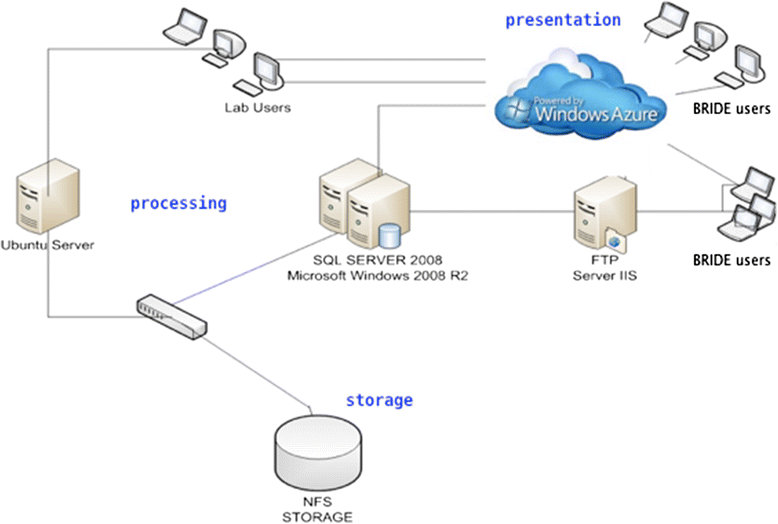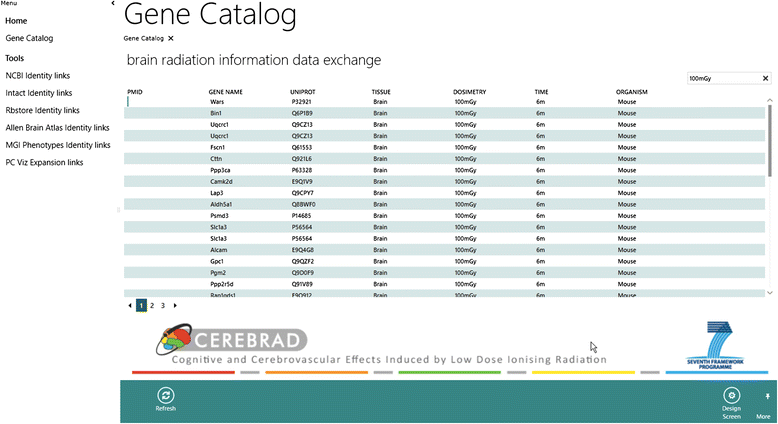Brain Radiation Information Data Exchange (BRIDE): integration of experimental data from low-dose ionising radiation research for pathway discovery
- PMID: 27170263
- PMCID: PMC4865096
- DOI: 10.1186/s12859-016-1068-8
Brain Radiation Information Data Exchange (BRIDE): integration of experimental data from low-dose ionising radiation research for pathway discovery
Abstract
Background: The underlying molecular processes representing stress responses to low-dose ionising radiation (LDIR) in mammals are just beginning to be understood. In particular, LDIR effects on the brain and their possible association with neurodegenerative disease are currently being explored using omics technologies.
Results: We describe a light-weight approach for the storage, analysis and distribution of relevant LDIR omics datasets. The data integration platform, called BRIDE, contains information from the literature as well as experimental information from transcriptomics and proteomics studies. It deploys a hybrid, distributed solution using both local storage and cloud technology.
Conclusions: BRIDE can act as a knowledge broker for LDIR researchers, to facilitate molecular research on the systems biology of LDIR response in mammals. Its flexible design can capture a range of experimental information for genomics, epigenomics, transcriptomics, and proteomics. The data collection is available at: <bride.azurewebsites.net>.
Keywords: Brain research; Data integration; Low-dose ionising radiation; Omics technologies; Systems biology.
Figures
Similar articles
-
People do not have high levels of knowledge of low dose ionizing radiation (LDIR).J Environ Radioact. 2024 Jan;271:107311. doi: 10.1016/j.jenvrad.2023.107311. Epub 2023 Nov 10. J Environ Radioact. 2024. PMID: 37952429
-
Therapeutic potential of low dose ionizing radiation against cancer, dementia, and diabetes: evidences from epidemiological, clinical, and preclinical studies.Mol Biol Rep. 2023 Mar;50(3):2823-2834. doi: 10.1007/s11033-022-08211-5. Epub 2023 Jan 3. Mol Biol Rep. 2023. PMID: 36595119 Free PMC article. Review.
-
Application of radiation omics in the development of adverse outcome pathway networks: an example of radiation-induced cardiovascular disease.Int J Radiat Biol. 2022;98(12):1722-1751. doi: 10.1080/09553002.2022.2110325. Epub 2022 Aug 24. Int J Radiat Biol. 2022. PMID: 35976069 Review.
-
Comparison of low and high dose ionising radiation using topological analysis of gene coexpression networks.BMC Genomics. 2012 May 17;13:190. doi: 10.1186/1471-2164-13-190. BMC Genomics. 2012. PMID: 22594378 Free PMC article.
-
Low-dose or low-dose-rate ionizing radiation-induced bioeffects in animal models.J Radiat Res. 2017 Mar 1;58(2):165-182. doi: 10.1093/jrr/rrw120. J Radiat Res. 2017. PMID: 28077626 Free PMC article. Review.
Cited by
-
Establishment of computational biology in Greece and Cyprus: Past, present, and future.PLoS Comput Biol. 2019 Dec 19;15(12):e1007532. doi: 10.1371/journal.pcbi.1007532. eCollection 2019 Dec. PLoS Comput Biol. 2019. PMID: 31856214 Free PMC article. Review. No abstract available.
-
Developing computational biology at meridian 23° E, and a little eastwards.J Biol Res (Thessalon). 2018 Nov 14;25:18. doi: 10.1186/s40709-018-0091-5. eCollection 2018 Dec. J Biol Res (Thessalon). 2018. PMID: 30460210 Free PMC article.
References
-
- De Angelis G, Caldora M, Santaquilani M, Scipione R, Verdecchia A. Radiation exposure of civilian airline crew members and associated biological effects due to the atmospheric ionizing radiation environment. Phys Med. 2001;17(Suppl 1):258–260. - PubMed
-
- Ginzburg HM, Reis E. Consequences of the Nuclear Power Plant Accident at Chernobyl. In: US Department of Energy; 1987. http://www.ncbi.nlm.nih.gov/pmc/articles/PMC1580196/pdf/pubhealthrep1500.... - PMC - PubMed
MeSH terms
LinkOut - more resources
Full Text Sources
Other Literature Sources




